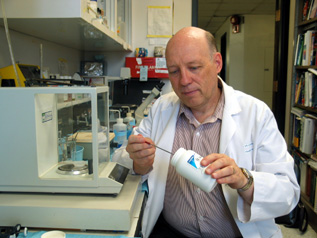 |
David Bylund, Ph.D. |
NIMH is part of the National Institutes of Health. The NIH, the premier public source of medical and behavioral research support in the United States, funds scientific studies at universities and research institutions across the country.
Like other drugs approved for use in humans, researchers first must test antidepressants in animals. Researchers may use animal models to screen a multitude of drugs. For anti-depressant drugs, researchers most commonly turn to adult rodent models.
Rodent models needed
But, researchers say a rodent model designed to test the effectiveness of antidepressants in children and adolescents is needed.
“There are no established juvenile rodent animal models of clinical depression,” said David Bylund, Ph.D., UNMC professor of pharmacology and principal investigator of the UNMC study titled “Animal Models of Childhood and Adolescent Depression. “We have reasonable rodent animal models for adults that predict more than 90 percent of how well drugs work in adult humans, but no one to this point has looked at models in the young animal to see what drugs might be effective in children and adolescents.
An important difference between clinical depression in children and adolescents, as compared to adults, is the response to anti-depressant drugs, he said.
Understanding antidepressants in kids
“Tricyclic antidepressants used in adults, for example, have not been shown to be effective in treatment of child and adolescent clinical depression,” Dr. Bylund said. “We think that tricyclics tend to work on a different neurochemical system in the brain than serotonin uptake inhibitor drugs.”
Researchers hope their study can explain the lack of effectiveness of the tricyclic antidepressants in children and adolescents and more importantly, a rodent model of child and adolescent depression should help predict the classes of antidepressants that will be effective in children and adolescents. There are many differences between juvenile and adult animals.
In their study, researchers will assess the validity and usefulness of two established rodent animal models of adult clinical depression as models of childhood and adolescent clinical depression.
Research studies with children
Research of antidepressants in children is a relatively recent phenomenon. Prior to the 1990s, it was generally considered unethical to do controlled clinical trials in children, Dr. Bylund said. But in the 1990s, when the U.S. Food and Drug Administration began allowing studies in young people, controlled clinical trials with tricyclic antidepressants showed no benefits in children compared to placebo. In the later 1990s, the FDA demanded studies be done in children.
Developing a model for pediatric depression
Christopher Kratochvil, M.D., UNMC child and adolescent psychiatrist who has been treating children and adolescents with depression for about eight years, said the study is unique because it looks at depression in children from a very different perspective.
“By developing a model for pediatric depression in animals, it could be much easier to assess potential treatments prior to progressing to human studies,” said Dr. Kratochivil, who is nationally known for his work in clinical research on pediatric depression. “We know, when compared to adulthood depression, pediatric depression can present quite differently in the clinic.
“Additionally, not all treatments that are effective in adults with depression are effective in children with depression,” he said. “This line of study may provide an effective way to conduct a systematic line of research on childhood depression, and learn much more about a very common problem in the pediatric population.”
Suffering from depression
It is estimated that up to 2.5 percent of children and up to 8.3 percent of adolescents in the U.S. suffer from depression. According to the NIMH, depressive disorders can have far-reaching effects on the functioning and adjustment of young people, including an increased risk for illness and interpersonal and psychosocial difficulties that persist long after the depressive episode is resolved.
In adolescents, there also is an increased risk for substance abuse and suicidal behavior. In addition, research indicates that today depression onset is occurring earlier in life than in past decades.
Although the scientific literature on treatment of children and adolescents with depression is far less extensive than that concerning adults, a number of studies — mostly conducted in the last four to five years — have confirmed the short-term efficacy and safety of treatments for depression in youth. Larger treatment trials are needed to determine which treatments work best for which youngsters.
Collaborating on the study
Also collaborating on the UNMC study is Frederick Petty, M.D., Ph.D., Creighton University Medical Center’s department of psychiatry vice-chairman of research.